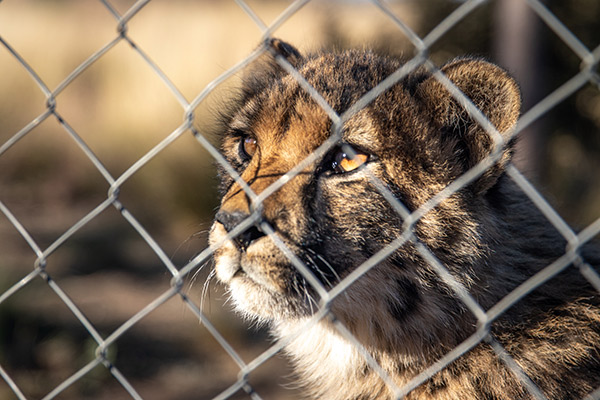Subtotal: $
Checkout
The Animals at the Zoo
A prison drama workshop pushes boundaries while navigating life inside them.
By Ashley Lucas
September 12, 2023
The Prison Creative Arts Project (also known as PCAP) began in 1990 with a single theatre workshop at a women’s prison in Michigan. A University of Michigan student named Liz Boner asked Professor Buzz Alexander if she could go into the local women’s prison to do a weekly workshop as part of his Theatre for Social Change class. Buzz agreed and decided to go with her. Inside the prison, the women changed Buzz’s life. The women in prison gained a great deal from the theatre as well and from their contact with Buzz and his students. Buzz decided to continue going to the women’s prison for twenty-five years. They called themselves the Sisters Within Theater Troupe. Though Buzz passed away in 2019, may he rest in peace, the Sisters continue with PCAP students and volunteers collaborating each week with the women. The Sisters are now in their thirty-second year of making theatre together, and they are the oldest continuously running theatre company inside a prison in the United States.

Photograph by Magda Ehlers.
When the Covid pandemic forced all of us out of prisons, PCAP students facilitated correspondence workshops with the Sisters by mailing activity packets to them each week and books for them to read together. It was not nearly as dynamic, fun, or energizing as the work we do in person, but at least we maintained contact with the Sisters throughout the years when we could not see them physically.
In January 2023, the Women’s Huron Valley Correctional Facility reopened its doors to volunteers offering programming at the prison, and we could finally see the Sisters in person again. As everyone had struggled greatly during the pandemic, people wanted to share their experiences, most of which condemned the terrible treatment they had received in prison. The prison authorities always have staff in the room during Sisters performances, and we are not allowed to criticize the prison itself or even really talk about it when we are performing. If we do, we know we will not be allowed to continue our work together. I encouraged the Sisters to use metaphors to talk about their prison experiences – to displace their ideas and actions into a different setting with outrageous characters so that even if everyone understood the metaphors being used, they would not be punished for criticizing the prison. The Sisters decided that they wanted to portray themselves as animals at the zoo.
This choice was controversial. Some of the Sisters felt strongly that this described how they felt and how they are treated, while others argued that they should not succumb, even in metaphor, to the ways that the prison treats them as animals. They wanted to claim a higher form of dignity and humanity than they felt the idea of the zoo afforded them. In the end they compromised by splitting into groups to create different scenes for the play.
The play began in a shopping mall where a woman was having a hard time buying a pair of shoes. The clerk behind the counter was on the phone and not helping her, and one of the other customers had two misbehaving children, one of whom kept taking off her own shoes, throwing them across the store, and then running over to retrieve them. One of the PCAP volunteers also acting in the play had the role of the shoe-throwing child, who reappeared several times during the play doing the same bit. I found this repeated gag to be not just funny but marvelously transgressive inside the space of the prison, where shoes must be worn everywhere, including in the showers. (I once met another group of incarcerated women in North Carolina who wrote a whole song about what it would be like to once again have the freedom to run in their bare feet.) The woman trying to buy shoes in this play eventually makes her purchase but has taken so long in getting them that she is too late to go to the movie that she wanted to see. She ends up going to the zoo instead.
At the zoo, a group of cheetahs in their enclosure take center stage while a group of goofy visitors, including the people we met at the mall, stand stage left trying to get a good look at them. The cheetahs have a conversation about how much they love each other and how great it is to get to spend all day every day together. One of the cats leaves the main part of their enclosure to go show off for the tourists. As soon as she has moved away from the group, the rest of the cheetahs start talking about all the ways that she drives them crazy, saying things like, “Oh my God! I hate how she’s always sneezing really loud and scratching her fleas!” Then the cheetah who had been performing for the tourists returns to the group sneezing and scratching and continues to do so for the rest of the scene. As each cheetah leaves and returns with obnoxious and comedic habits, pandemonium ensues. The cage is full of super annoying big cats who cannot escape one another’s constant presence.
This scene grew out of a game called Circle of Friends that we often use at PCAP. In its more condensed form, three actors are given a location and an occupation, and they have to improvise a conversation while working together. As each person’s annoying traits are revealed, the scene becomes more and more outrageous until they have no choice but to end it, usually by some or all of them fleeing the stage. It never fails to be uproariously funny and is very popular in our workshops.
The Sisters’ interpretation of this game became something much deeper. Most of the roles were played by about six incarcerated actors with two of my college students mixed in. All of them had drawn cat noses and whiskers on their faces, and most of them wore prison uniforms. The group was large enough to make the stage feel very full when everyone’s annoying habits had emerged, yet they were limited in how much space they could occupy without running into one another, especially with the crowd of zoo visitors watching from stage left. The scene cannot end with everyone having to run away from one another because these cheetahs are trapped at the zoo. Instead, they must learn to live together. They calmed down a bit and talked about the fact that they don’t always like each other, but they do really care about each cat in the group. They agree to try to be less annoying to one another, and that’s the resolution to the scene. The Sisters didn’t imagine themselves out of prison. They chose to imagine a way to live together in very difficult circumstances while the world outside watches and fails to understand them or their struggles.
The next scene involved a group of zoo workers forming a support group. The actors in this scene had each written a poem or monologue that they wanted to deliver somewhere in the play, and the convention they had chosen was to invite the audience into a call-and-response moment at the end of each woman’s piece. The speaker would look to the audience and say, “Do you see me?” and we would respond, “I see you!” The individual performances in this section mostly dealt with feelings of being invisible in their lives. Some pieces seemed to allude to life in prison but didn’t address it directly, while others described feeling unseen and unheard within their families or childhoods outside of prison.
The fact that scene was framed with the idea that they were all zookeepers made me wonder whether the incarcerated actors knew how misunderstood and trapped many prison guards also feel. Mary Heinen McPherson was one of the original Sisters when the group was formed in 1990, performed with them for ten years inside prison, and now has been free for twenty-one years and works for PCAP to train and supervise volunteers. When I asked her how aware incarcerated women would be of the guards’ feelings about their jobs, she said:
Women prisoners are especially aware guards feel imprisoned because they talk about it frequently and in no uncertain terms. In fact, guards come in to work with bad teeth, bad shoes, poor hygiene, hung over, disheveled, you name it. They tend to clean up their act over time, experience, and more paychecks. And they tend to loudly bemoan their condition.
In an eerie way, the zookeepers’ support group meeting could have been about either incarcerated people or prison staff. I have met many people working in prisons who feel like this dead-end government job is their only option even though they hate spending all day in prison and the work they have to do. Prisons have a way of profoundly harming everyone who spends much time inside them.
Toward the end of the play, the people who had been shopping finally open the shoe box to have a look at their purchase. Inside they find two completely mismatched shoes. This moment was played for comic effect, but it also felt poignant. This woman had just wanted to buy a pair of shoes, and she lost a whole day in her efforts only to discover that she did not get what she needed and cannot wear these shoes. She must begin again if she can find the time and money to do so. This felt too familiar. It’s the kind of thing that routinely happens to working-class people, to people coming out of prison and trying to rebuild their lives, to the very people who have no time or money to spare yet still need to acquire many things in order to survive. What should be simple is often so hard and can have devastating consequences.
On the night of the performance, I sat next to a longtime poet named Tracy Leigh who has been featured in many editions of PCAP’s literary journal, the Michigan Review of Prisoner Creative Writing. She was radiant with joy when I saw her that night. As the play unfolded, she would whisper to me that what a character had said described just how she felt or that she knew it took bravery for a particular woman to perform that scene. The play moved me in many different ways, but the experience was all made richer because I was allowed to share it with Tracy and hear her insights along the way. She reminded me how important this work of the theatre is, not just for the performers but also for audiences.
In the end, the Sisters managed the difficult task they had set for themselves. They created a fun and entertaining play that critiqued the prison system without naming it. They made space for the women who felt that the zoo metaphor described their lives and for the ones who did not want to entertain the idea that they are animals. They came together again in person to perform and rebuild their historic community and theatre company. They spoke to an audience who shouted back “I see you!” – and meant it.
This essay is adapted from a panel talk on prison theatre at I Congresso Internacional de Teatro do Amazonas (CITA) [the First International Theatre Conference of the State of Amazonas] delivered on May 14, 2023, in Manaus, Amazonas, Brazil.
Already a subscriber? Sign in
Try 3 months of unlimited access. Start your FREE TRIAL today. Cancel anytime.






